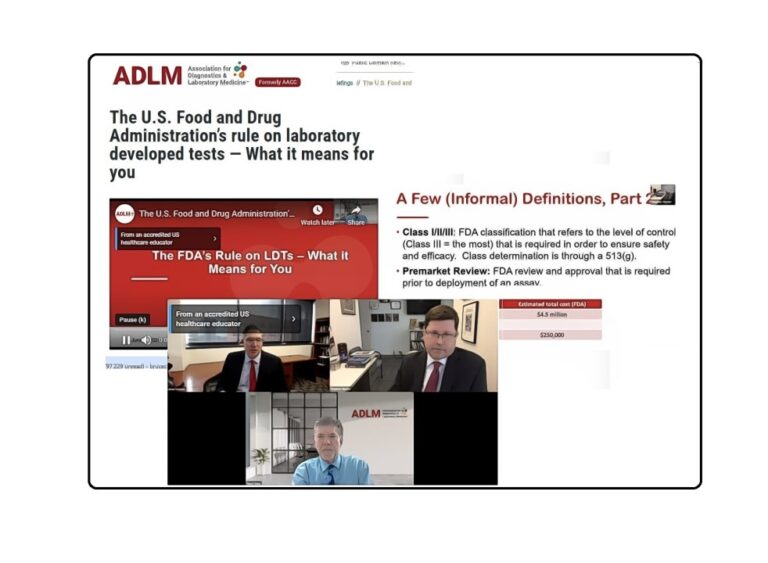“You’ve been speeding all along, we just haven’t chosen to pull you over yet.” that is my paraphrase of the framing of FDA enforcement of lab-developed tests under the rule announced April 2024. This was a point emphasized at the recent ADLM webinar on the new LDT rule, essentially: labs conducting lab-developed tests have been in violation since 1976. This was one of the many points hammered home by an informative webinar conducted by the largest association of laboratorians and the suppliers who support them, the ADLM (formerly AACC).
The webinar is available here: https://www.youtube.com/watch?v=X1Go-G5Gdrs Highly suggest a watch. I cannot replicate all the points made in the informative discussion by experts, including an expert from Children’s Hospital in Philadelphia, a medical officer at ARUP, and the ADLM’s Senior Director of Governmental Affairs.
Other points made: lab-developed tests are now (as of May 2024) a device, and require compliance for use. That means labs need to devote staff, money, and resources to make them complying devices in the eyes of the regulatory bodies. It’s going to take new budget meetings in the halls of hospital systems, to make administrators understand and allocate. It will put legal responsibility on labs instead of manufacturers in many cases (such as tests that use RUOs). It will mean labs will have to retrain existing staff, and most likely: hire new employees. And even when all that’s done, it could all be upended by courts or politicians.
Thus the scene was set well by the #ADLM in their recent webinar. While the discussion was educational and not remotely a gripe session, it nonetheless aimed for the tone of the new rule: “There’s a lack of trust in the quality of work of laboratories – and that’s an unfortunate concept. We are delivering outstanding outcomes. I would like a regulatory structure that supports that.”
As background: approximately 12,000 laboratories in the United States are eligible to perform laboratory-developed tests (LDTs). LDTs often serve as the only means of identifying rare medical conditions or providing invaluable information to clinicians when existing U.S. Food and Drug Administration (FDA) cleared or approved tests do not provide the data needed to diagnose and treat a patient.
The FDA published a final rule on May 6, 2024, which extends agency oversight to laboratory-developed tests. Clinical laboratories performing such tests will be considered medical device manufacturers for regulatory purposes.
The ADLM says “Many Association for Diagnostics & Laboratory Medicine (ADLM, formerly AACC) members perform LDTs as part of their job, including developing the tests, verifying and overseeing their performance, and reporting the patient results. The agency rule will significantly impact the ability of our members and their institutions to offer these tests.”
“ADLM notes that a strict reading of…the final rule is that labs have been in violation of the law since 1976.”
As long as the final rule was, it does not address all the questions ADLM is receiving from its members. In addition to providing useful information for laboratories to be sure they understand compliance, ADLM listed several areas where answers are needed from the FDA:
- What are the requirements during the transition period?
- What happens if you need to make a switch in an LDT because you lose a vendor, when you need to swap reagent brands to continue to service patients – how do you do that?
- What counts as a significant change? New Instrument, different instrument/same class? Different instrument /related class? (“The example the FDA uses is if you replace an immunoassay with a mass spectrometer, but we don’t know where the line is going to be.”) For instance what if it’s just a different type of mass spec instrument?
- If a change in the indication removes “currently marketed” status for enforcement discretion, how will the FDA determine the approved indication for the test?
- Clarification on automation: The FDA says automation can make a test an LDT but the FDA “lumps all types of automation under this single word” where there are many types of automation and partial automation, such as liquid handlers, and automated pipettes.
- What is the line (if any) between manufacture (FDA) and lab operations (CLIA)? If performing the lab test is manufacturing, is a QC or PT failure subject to 21 CFR 820 [medical device regulatory] tracking? For example, corrective procedures under subpart J, as would a medical device company.
- Will patients have to travel to get rare disease testing and treatment at FDA-approved centers? What if they are unable to travel?
- Now that labs are manufacturers per the FDA, can laboratorians advise colleagues about “off-label” uses of tests?
These were just some questions raised by the ADLM speakers that the FDA would need to answer. They are referring their own lab members to the agency to ask them.
And even when these questions are answered, there is still uncertainty for labs. Concluding the webinar, Vince Stine, ADLM’s Senior Director of Governmental Affairs said “I’m going to introduce more complexity. Usually, when you hear final rule this means final. There are a number of wildcards out there right now. “
“As you are making decisions there are things that can affect whether or not this rule sees the light of day” – Vince Stine, ADLM Senior Director Governmental Affairs.
First of all: Congress can revoke the rule, modify the rule, or put it on hold. It can revisit VALID or CLIA modernization. But it’s Congress. So there’s no telling when that may happen or with a divided government if it will. The ACLU lawsuit challenging if the FDA has this authority. And then there’s the election, which could change the course of enforcement as well.
Another way of saying this: is uncertainty is the final burden on labs.
View the full ADLM LDT webinar – https://www.youtube.com/watch?v=X1Go-G5Gdrs
Now, as my coverage zone is IVDs, it might be asked: how does this affect IVDs? I continue to believe that though some IVD companies, or departments within IVD companies, will rejoice (maybe high-end oncology IVD test makers), anything that hurts labs hurts IVD. Uncertainty alone hurts labs. When hurt, actors will stop activities, or consolidate for safety. Anything that tends to consolidate labs cannot be good for those that supply them.
A few dollars will be earned on one end, but in terms of reagent or instrument sales for LDTs, there could be an unforeseen reduction. Also, the opportunity presented by the final rule may not be so great because most LDTs are conducted for rare conditions, and large LDTs competing with IVDs already on the market will have some discretion and are in pretty good shape to comply. Finally consolidation of customers due to complexities of compliance – regulation almost always is easier for bigger customers to take, consolidation long-term is not the friend of IVD pricing.
We’ll continue to cover the LDT issue on Eye on IVD. Please recommend Eye on IVD to a colleague if you think they might benefit.
A note that we are very close to releasing our first market research report, INFECTIOUS DISEASE IVD MARKET REVIEW.



